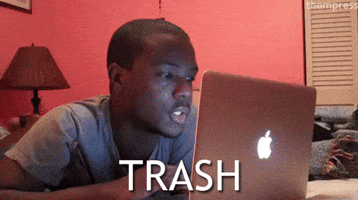- The Pragmatic Investor
- Posts
- 📉 Most Portfolios Are Trash — Own 5 Winners Than 20 Duds
📉 Most Portfolios Are Trash — Own 5 Winners Than 20 Duds

🌞Good Monday Morning, Folks!
This is going to piss off some people.
But here’s the truth:
Most portfolios aren’t built — they’re accidents. A Frankenstein mashup of hype stocks, half-baked ideas, and whatever someone saw trending on Reddit last week. And when the market pulls back? Boom — the whole thing collapses like a Jenga tower on caffeine.
It doesn’t have to be that way.
The best investors I know aren’t obsessed with finding the next 10-bagger. They’re obsessed with owning businesses they’d proudly hold through a recession, an election, and a 20% drawdown. Winners that actually stay winners.
Today’s One Big Idea? It’s the kind of mental reframe most retail investors never hear — but absolutely need.
Because building a real portfolio isn’t about being right often. It’s about being right long enough to let compounding do its job.
Let’s fix the mess before it spreads.
TOGETHER WITH OUR PARTNER
Find out why 1M+ professionals read Superhuman AI daily.
AI won't take over the world. People who know how to use AI will.
Here's how to stay ahead with AI:
Sign up for Superhuman AI. The AI newsletter read by 1M+ pros.
Master AI tools, tutorials, and news in just 3 minutes a day.
Become 10X more productive using AI.
⚡ Quick Hits
Everyone’s asking the wrong question. It’s not can you retire with $400K — it’s how long can you afford to stay retired without running out of money.
With inflation dragging, market returns compressing, and healthcare costs exploding, the bar for “enough” has quietly risen. If you're still using old retirement math, you're underestimating risk — and time is your biggest liability.
A new lawsuit is demanding the FOMC open its doors to the public — a legal curveball that could pierce the Fed’s veil of secrecy.
Why it matters? If transparency wins, it could fundamentally shift how markets price in rate decisions. Volatility traders and institutional quants are already paying attention. Retail isn’t — yet.
Consumers aren’t “tapping out” — they’re just getting weirder. They're trading down, mixing luxury with cheap beer, and rewriting what a slowdown looks like.
This isn't your textbook recession. It’s fragmented, unpredictable, and totally misunderstood by traditional models. If you’re using 2008-era playbooks to invest in 2025, you're flying blind.
💡One Big Idea: 📈 Why My Portfolio Has More Winners Than Losers (And Yours Should Too)
I’ll be blunt.
If your stock portfolio looks like a warzone—bleeding red and gasping for green—you’re not investing. You’re guessing.
I’ve seen this too many times: portfolios packed with hype stocks, no diversification, chasing whatever TikTok’s talking about this week. Then the market dips, and it all crumbles like a house of cards.
But here’s the truth nobody tells you on YouTube or Reddit:
A well-constructed portfolio should not have equal winners and losers. It should be skewed—heavily—to the upside.
I’m talking 70% winners, 30% laggards. Sometimes even 80/20.
If that sounds like fantasy, it’s not. It’s discipline.
Let’s break this open.
🧠 Why Most Portfolios Suck (And How to Spot Yours)
First, a gut check.
Open your portfolio. Look at every stock.
Ask yourself:
Do I even know why I bought this?
What was the thesis?
What’s the actual catalyst for upside?
If you can’t answer those questions in under 30 seconds per stock… that’s a problem.
The average retail investor thinks they’re diversified because they hold 10–15 tickers. But if all of them are tech, or all are small-cap flyers with no earnings, that’s not diversification. That’s duplication.
I’ve audited dozens of retail portfolios from people I coach, and the recurring issue is this:
“I thought more stocks = less risk.”
Nope. More conviction in fewer, well-researched winners = less risk.
You only need 5–7 great positions to build real wealth. The rest? They're ballast at best, deadweight at worst.
🧩 The Anatomy of a Well-Built Portfolio
Let me give you my mental model. I call it The Barbell Portfolio.
It's not original—but it works like hell.
I split my portfolio into:
1. Core Compounders (60–70%)
These are the stocks I’d hold if the market shut down for 5 years. Think Apple, Microsoft, Costco, Berkshire Hathaway.
They have:
Durable moats
Clean balance sheets
Strong free cash flow
Dividend optionality
I don’t babysit these. I let them run. When they dip, I buy more.
Recent Winners in My Core:
$MSFT up 38% YTD
$COST up 28% YTD
$AVGO (Broadcom) +50% YTD
You don’t need fireworks. You need consistency.
2. Growth Accelerators (20–30%)
These are your future compounders. They’re not proven yet, but they’re scaling fast with strong tailwinds.
My filters:
Revenue growth >20%
Path to profitability within 18 months
Founder-led (ideally)
My current picks:
$PLTR (Palantir) – AI + government contracts + commercial growth
$CELH (Celsius) – disruptive brand in a massive market
$NVDA (Nvidia) – yes, still a growth machine despite the headlines
Some may stall. One or two might pull back 30%. That’s okay.
If even one of these turns 3x or 5x over 3–5 years, they lift the whole portfolio.
3. Asymmetric Bets (5–10%)
These are high-risk, high-reward shots with limited capital. Biotech. Emerging tech. Deep value. Turnarounds.
The goal here is optionality, not certainty.
If I lose 100% on one of these, the loss is tiny.
But if one hits… it could be the next $TSLA or $SHOP.
Right now?
I’m watching $DNA (Gingko Bioworks) for biotech optionality
$SOFI for long-term fintech disruption
I size these tiny. Emotionally, I write them off the moment I hit “buy.”
🧪 The 10-Point Stock Clarity Screener
The Ultimate Checklist Before You Buy ANY Stock
Every stock I hold has to clear this 10-point clarity filter.
It keeps me honest. It kills FOMO. And it ensures I only buy businesses I actually understand and can confidently hold through noise.
Here's the checklist:
UNDERSTANDABLE?
Do you fully understand how this company makes money?REVENUE GROWTH?
Is it increasing consistently year-over-year?PROFITABLE?
Consistently profitable (positive net income)?FREE CASH FLOW?
Producing cash in excess of capital expenditures?DEBT LEVEL?
Healthy debt-to-equity ratio (below 1.5)?INSTITUTIONAL?
Do institutions own more than half the stock?TRENDS?
Is the company riding a secular or macro trend?LEADERSHIP?
Trustworthy management with long-term vision?MOAT?
Does it have a defensible competitive advantage?HOLD-WORTHY?
Are you comfortable holding this for 5 years or more?
PRO TIP:
If you can’t understand the business, it’s best to avoid the stock and move on to something that is easier to comprehend.
🟢 Score It:
8–10: STRONG BUY
6–7: RESEARCH MORE
Below 6: AVOID
✅ Want the one-page PDF version? Download the Clarity Screener here
🔥 The Portfolio Tilt That Makes You Wealthy
Let’s run some real math.
Imagine you hold 10 stocks.
6 of them return +30% over 12 months
3 of them are flat or down -5%
1 is a loser, down -40%
Your total return = ~+12.5% even with a massive loser in the mix.
Now flip it.
6 stocks are down -10%
3 are flat
1 wins, up +40%
Total return = ~-4%
This is the essence of portfolio skew.
It’s not about being right every time. It’s about being right big and wrong small.
That’s how pros build wealth over decades. Not by hitting 100% accuracy—but by letting their best ideas carry the weight.
🧱 Build It Like a Fortress, Not a Fantasy
You don’t need to be a genius to beat the market.
You need:
A structured approach
Emotional discipline
And a mindset that avoids mediocrity and rewards asymmetric thinking
I know this sounds raw. That’s because it is.
I’ve been burned. I’ve held 30-stock portfolios that did nothing for 3 years.
And I’ve held 7-stock portfolios that grew 30% in a single year.
More winners than losers isn't a fluke—it’s a feature of good process.
So build your portfolio like your future depends on it—because it does.
📥 Want My Stock Scoring System?
🧠 Grab the 10-Point Stock Clarity Screener PDF—the one I use every time I buy a stock. Download my 10-point screener — free for long-term investors who want clarity before conviction.
Over 2,500 readers have grabbed this already — don’t miss out
TOGETHER WITH OUR PARTNER
Investment picks returning 200%+
AIR Insiders get weekly expert investment picks and exclusive offers and perks from leading private market investing tools and platforms. So if you’re looking to invest in private markets like real estate, private credit, pre-IPO venture or crypto, the time to join FOR FREE is now.
🧠 Final Thought
Most people think building a winning portfolio is about stock picking. It’s not. It’s about self-selection — choosing to own businesses you understand deeply, believe in fully, and are willing to hold through discomfort. That kind of ownership feels different. You stop checking prices obsessively. You start thinking like an operator, not a gambler. The winners don’t just rise — they compound because you gave them the time to.
The hard part isn’t finding more good stocks. It’s resisting the temptation to dilute your edge with noise. The more I invest, the more I realize: clarity isn’t a research problem — it’s a discipline problem. When your process is clean, your portfolio reflects it. And the truth is, most of the real upside shows up only after you’ve proven to the market — and to yourself — that you’re willing to wait for it.
🧠 What did you think of today's newsletter? |
— AK

Disclaimer: The content on this blog is for educational and informational purposes only and is not intended as financial, investment, tax, or legal advice. Investing in the stock market involves risks, including the loss of principal. The views expressed here are solely those of the author and do not represent any company or organization. Readers should conduct their own research and due diligence before making any financial decisions. The author and publisher are not responsible for any losses or damages resulting from the use of this information.



Reply